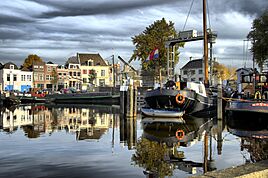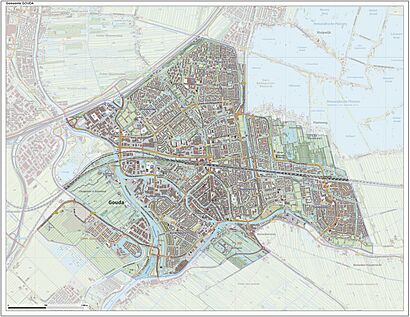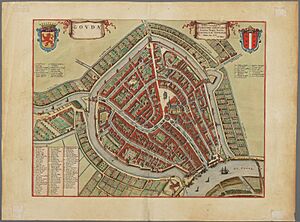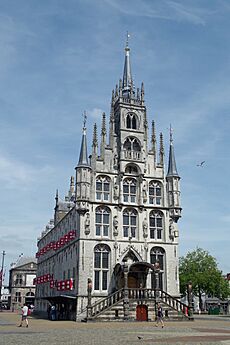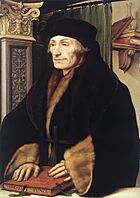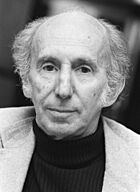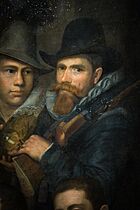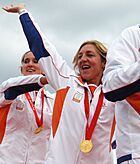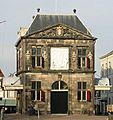Gouda, South Holland facts for kids
Quick facts for kids
Gouda
|
|||
|---|---|---|---|
|
City and municipality
|
|||
|
Panoramic view of the city
City centre
Historic town hall
Port
|
|||
|
|||
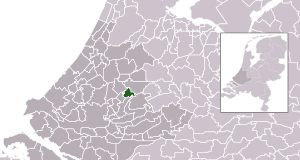
Location in South Holland
|
|||
| Country | Netherlands | ||
| Province | South Holland | ||
| Government | |||
| • Body | Municipal council | ||
| Area | |||
| • Total | 18.11 km2 (6.99 sq mi) | ||
| • Land | 16.86 km2 (6.51 sq mi) | ||
| • Water | 1.25 km2 (0.48 sq mi) | ||
| Elevation | 0 m (0 ft) | ||
| Population
(May 2014)
|
|||
| • Total | 70,939 | ||
| • Density | 4,208/km2 (10,900/sq mi) | ||
| Demonym(s) | Gouwenaar | ||
| Time zone | UTC+1 (CET) | ||
| • Summer (DST) | UTC+2 (CEST) | ||
| Postcode |
2800–2809
|
||
| Area code | 0182 | ||
Gouda is a lively city and municipality in the western part of the Netherlands. It's located between the larger cities of Rotterdam and Utrecht, in the province of South Holland. About 75,000 people live in Gouda. The city is super famous for its delicious Gouda cheese, sweet stroopwafels, and its many historic canals called grachten. It also has a beautiful 15th-century city hall. With its amazing old churches and buildings, Gouda is a popular place for a day trip.
Long ago, in the Middle Ages, a family called Van der Goude started a settlement here. They built a strong castle next to the Gouwe River. Both the family and the city got their names from this river. People used to call the settlement Ter Goude, or Tergou for short.
This area was originally a marshland, which is a wet, grassy area. Over about 200 years, it grew and changed. By 1225, a canal was built to connect to the Gouwe River, and its mouth became a busy harbour. In 1272, Floris V, Count of Holland gave Gouda special city rights. This meant it could govern itself and hold markets, which helped it grow even more.
Contents
History of Gouda
Around the year 1100, the area where Gouda is now was a swampy place covered with a peat forest. Small streams, like the Gouwe, flowed through it. People started digging up peat (a type of soil that can be burned for fuel) along the Gouwe's banks in the 11th and 12th centuries. The name Gouda was first written down in a document in 1139.
Growth and Challenges
In the 13th century, the Gouwe River was connected to the Old Rhine by a canal. The river's mouth at the Hollandse IJssel became a busy harbour. A castle was built to protect this important harbour. This water route was used for trading goods between Flanders, France, Holland, and the Baltic Sea. In 1272, Gouda was granted city rights by Floris V, Count of Holland, making it a very important town. City canals, known as grachten, were dug to help transport goods through the town.
Gouda faced tough times with big fires in 1361 and 1438, which caused a lot of damage. In 1572, the city was taken over by Dutch rebels, known as les Gueux, who also caused destruction. The castle of Gouda was taken down starting in 1577.
The oldest inn that is still open today, De Zalm, was founded in 1551. You can find it on Markt 34, close to the historic Waag building.
Plague and Economic Struggles
Gouda suffered from serious plague outbreaks in 1574, 1625, 1636, and 1673. The last one was the worst, with almost 3,000 people dying, which was 20% of the city's population.
Towards the end of the 16th century, Gouda had big economic problems. It got better in the early 17th century and even did very well between 1665 and 1672. But then, the Franco-Dutch War started in 1672, and the plague returned in 1673, causing the economy to crash again. After 1700, Gouda had a good period until 1730, but then it went into a long decline that lasted until the 19th century. During this time, Gouda was one of the poorest cities in the Netherlands.
Modern Development
Starting in 1830, the old city walls began to be taken down. The last city gate was removed in 1854. Gouda only started to get better economically from the second half of the 19th century. New factories, like the Stearine Candle Factory and the Mechanized Yarn Spinnery, helped the economy grow. In 1855, the railway line connecting Gouda to Utrecht opened.
In the early 20th century, Gouda started to expand beyond its old moats. New neighborhoods like Korte Akkeren and Kort Haarlem were built. After World War II, even more areas like Oosterwei, Bloemendaal, and Goverwelle were developed.
Some of the city's old moats and canals were filled in starting in 1940. However, people protested, and city planners changed their minds. So, Gouda stopped filling in these historic waterways, which are now seen as very valuable. In 1944, the railway station was damaged during a bombing raid by the Allies, which aimed to destroy the railway lines.
After the war, the city grew a lot, almost tripling in size. Today, instead of just expanding, Gouda focuses on improving its existing areas and making them nicer places to live.
Population Changes
| Historical population | ||||||||||||||||||||||||||||||||||||||||
|---|---|---|---|---|---|---|---|---|---|---|---|---|---|---|---|---|---|---|---|---|---|---|---|---|---|---|---|---|---|---|---|---|---|---|---|---|---|---|---|---|
|
|
|||||||||||||||||||||||||||||||||||||||
Gouda's Economy
Gouda is most famous for its Gouda cheese. You can still see this cheese being traded at the traditional cheese market every Thursday. Gouda is also known for making candles, smoking pipes, and the delicious stroopwafels. In the past, Gouda also had a big linen industry and many breweries that made beer.
It's interesting to know that Gouda cheese isn't actually made in the city itself. Instead, it's made in the farms and villages around Gouda. It gets its name because it was traditionally traded in Gouda. The city council made sure the cheese met high quality standards, which helped make it famous.
Today, the economy in the city centre relies a lot on tourism, fun activities, and shops. Offices are mostly located on the edges of the city. There are over 32,000 jobs in Gouda, mainly in business and healthcare services.
Fun Places to Visit in Gouda
Gouda has many amazing historic places to explore:
- Old City Hall: This beautiful building is on the Markt square. It was built between 1448 and 1450 and is one of the oldest Gothic city halls in the Netherlands.
- The Waag (Weigh House): Built in 1667, this building is right across from the Old City Hall. It was used to weigh goods, especially cheese, so that taxes could be collected. Today, it's a national monument and even has a small cheese museum inside!
- Grote or St. Jans Kerk (Great or Saint John's Church): This is the longest church in the Netherlands. It's famous for its stunning stained glass windows, which were made between 1530 and 1603. These windows are considered the most important collection of stained glass in the Netherlands. Even hundreds of years ago, people came to see them!
- Museum Gouda: This museum teaches you all about the history and art of the city.
- Museumhaven Gouda: This is a small harbour where you can see historic ships.
- Goudse Schouwburg: A large and modern theatre where you can watch shows.
- Waaiersluis (Waaier Locks): This is a historic lock on the Hollandse IJssel river, just east of Gouda. It's a cool example of old engineering.
Exciting Events in Gouda
Gouda hosts several fun events throughout the year:
- Gouda Cheese & Craft Market: This market happens every Thursday from April to August, from 10:00 AM to 1:00 PM. It's a huge draw for tourists, with about 60,000 visitors each year!
- Gouda Ceramics Days: A yearly two-day event where ceramists from the Netherlands and other countries show off their work. You can see many exhibitions around the Old City Hall.
- Gouda's Monmartre: This is an antique, curio, flea, and collector's market. It takes place weekly on Wednesdays around the Old City Hall during the summer months.
- Gouda Water City Festival: A fun festival that celebrates Gouda's connection to water.
- Gouda by Candlelight: This is a magical annual Christmas event held in mid-December. A large Christmas tree, which is a gift from Gouda's sister city Kongsberg, is lit up in the market square. Famous Dutch singers and choirs perform carols. The windows of the Old City Hall and nearby houses are beautifully lit by Gouda candles, creating a wonderful atmosphere.
Music Scene
- Warmaster: An old school death metal band.
Getting Around Gouda
Gouda has two railway stations: Gouda and Gouda Goverwelle. From the main Gouda station, you can catch Intercity trains to The Hague, Rotterdam, and Utrecht. There are also local trains to Amsterdam and Alphen aan den Rijn/Leiden.
The city is also easy to reach by car, as it's located near the A12 and A20 motorways.
Gouda's Sister Cities
Gouda is twinned with these cities, meaning they have special friendly relationships:
|
|
|
Famous People from Gouda
Many notable people have come from Gouda, making their mark in different fields.
Thinkers and Public Service
- Desiderius Erasmus (1466–1536): A very famous Dutch philosopher and scholar who was a key figure in the northern Renaissance.
- Cornelis de Houtman (1565–1599) and Frederick de Houtman (1571–1627): Brothers who were explorers on the first Dutch trip to the East Indies.
- Hieronymus van Beverningh (1614–1690): A diplomat, a hobby botanist (someone who studies plants), and a supporter of the arts.
- Hieronymus van Alphen (1746–1803): A lawyer who also wrote poems for children.
- Wim Deetman (born 1945): A politician and teacher who was a municipal councillor in Gouda.
- Ad Melkert (born 1956): A Dutch politician, diplomat, and director of non-profit organizations.
Science and Business
- Nicolaas Hartsoeker (1656–1725): A mathematician and physicist who invented the screw-barrel microscope.
- Pieter Johannes van Rhijn (1886—1960): A Dutch astronomer.
- Jan Schilt (1894–1982): A Dutch-American astronomer who invented the Schilt photometer, a tool for measuring light.
- Leo Vroman (1915-2014): A Dutch-American hematologist (a doctor who studies blood), poet, and illustrator.
- Peter Stas (born 1963): A Dutch business owner and author, who is the CEO of Frédérique Constant, a watch company.
Artists and Creatives
- Dirk Crabeth (1501—1574) & Wouter Crabeth I (1510-1590): Brothers who were famous Dutch Renaissance glass painters.
- Pieter Pourbus (ca.1523–1584): A Flemish Renaissance painter known for portraits and religious scenes.
- Cornelis Ketel (1548–1616): A Dutch Mannerist painter.
- Frederick de Wit (ca.1630–1706): A cartographer and artist who drew, printed, and sold maps.
- Rozalie Hirs (born 1965): A Dutch composer of modern classical music and a poet.
- Marco de Goeij (born 1967): A composer who famously reconstructed Concerto for Group and Orchestra by Jon Lord.
Sports Stars
- Dick van Dijk (1946–1997): A football player with over 250 club games.
- Ed de Goey (born 1966): A former goalkeeper who played many club games and 31 games for the Netherlands national football team.
- Gillian van den Berg (born 1971): A water polo player who won a gold medal with her team at the 2008 Summer Olympics.
- Andrea Nuyt (born 1974): A retired speed skater who competed in the 1998 and 2002 Winter Olympics.
- Ellen Hogerwerf (born 1989): A rower who won a silver medal with her team at the 2020 Summer Olympics.
- Froukje Wegman (born 1979): A rower who won a bronze medal with her team at the 2004 Summer Olympics.
- Paulien van Deutekom (1981-2019): A Dutch champion speed skater who competed at the 2006 Winter Olympics.
- Bianca de Jong-Muhren (born 1986): A Dutch chess player who holds the title of Woman Grandmaster (WGM).
- Mieke Cabout (born 1986): A water polo player who won a gold medal with her team at the 2008 Summer Olympics.
- Ted-Jan Bloemen (born 1986): A Dutch-Canadian long track speed skater who won gold and silver medals at the 2018 Winter Olympics.
- Michael van der Mark (born 1992): A Dutch motorcycle racer.
Images for kids
See also
 In Spanish: Gouda para niños
In Spanish: Gouda para niños




